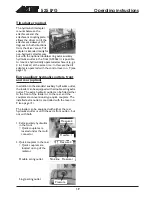
525 LPG
Operating instructions
15
Attachment control
switch pack (option)
Optional extra with which
electric functions of the
attachment are controlled
Does not require the
optional 8 function joystick
on the loader.
Consists of socket that
mounts on the boom. The
electric harness of the
attachment is connected
to this socket, and the
electric features are
controlled with switches
mounted on the boom
control lever.
Read the operators
manual of the attachment
to see how the switches
are used with each
attachment.
Control of loader boom, auxiliary hydraulics and other functions
Most of the functions of the loader are controlled at the control panel on the right side of the operator: Boom
and bucket movements, auxiliary hydraulics (attachments), engine revs etc. , depending on loader model.
Following pictures show the different functions:
5. Control lever of boom and bucket
(Functions of the optional electric joystick are explained on page 18)
Pull backward to lift the boom
Push forward to lower the boom
Push left to raise the tip of the bucket (filling)
Push right to lower the tip of the bucket (emptying)
6. Hand throttle lever
Push forward to increase engine revs
Pull backward to reduce engine revs
7. Control lever of auxiliary hydraulics
(hydraulically operated attachments)
Push forward: Hydraulic flow to pressure 1
coupler. Move the lever carefully to see which
way the hydraulic attachment moves.
Pull backward: the attachment moves in opposite
direction
Locking position: Continuous flow to pressure
1 coupler.
8. Control lever of telescopic boom
(optional extra)
Push forward to extend the boom
Pull backward to retract the boom
9. Control lever of extra auxiliary hydraulics
outlet (optional extra)
The control lever operates either the rear
hydraulics outlet or the extra front outlet.
Push f locking position: Move the lever
carefully to see which way the hydraulic
attachment moves.
Pull backward: the attachment moves in opposite
direction
10.Selection lever of the pumps for auxiliary
hydraulics
Lever in front position (1-pump): one pump
coupled for auxiliary hydraulics
Lever in back position (1-pump): both pumps
coupled for auxiliary hydraulics
5
6
7
8
9
10



































